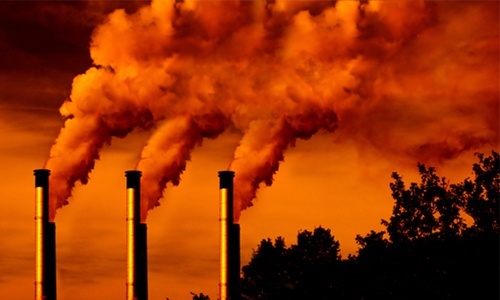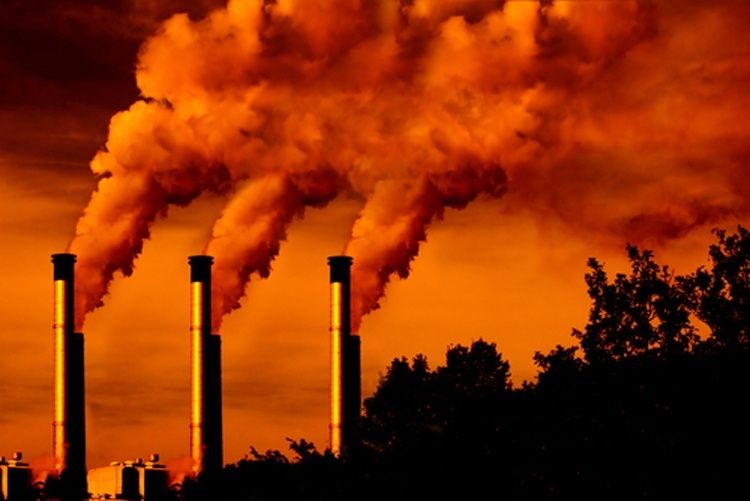
Carbon Levels Rising at ‘Frightening Speed’ as Greenhouse Gases and Global Temperature Hit Record High

Atmospheric greenhouse gas concentrations hit yet another new record in 2014, “continuing a relentless rise which is fueling climate change and will make the planet more dangerous and inhospitable for future generations,” said the World Meteorological Organization (WMO) in a report released today.
The WMO Greenhouse Gas Bulletin found a 36 percent increase in greenhouse gas emissions in the last 25 years and a 43 percent increase from pre-industrial levels. The report also highlighted the “enhanced greenhouse effect” that more water vapor in the atmosphere is having. As the Earth’s surface temperature warms because of record CO2 concentrations, it’s creating a “vicious cycle” where “higher temperatures lead to more atmospheric water vapor,” explains the Guardian, “which in turn traps even more heat.”
Levels of two other major greenhouse gases, methane and nitrous oxide, rose “at the fastest rate for a decade,” reports Reuters. In 2014, methane levels reached 1,833 parts per billion (ppb) and nitrous oxide levels reached 327.1 ppb.
“We will soon be living with globally averaged CO2 levels above 400 parts per million as a permanent reality,” said WMO Secretary-General Michel Jarraud.
In the Northern hemisphere, CO2 concentrations reached 400 parts per million (ppm) in the spring of 2014 (when CO2 is most abundant), and the global average reached 397.7 ppm. Then, this past spring the global average “crossed the 400 ppm barrier,” reports the WMO. March marked the first time ever that global carbon levels surpassed 400 ppm for an entire month. To avoid catastrophic climate change, scientists have said global concentrations need to be below 350 ppm.
Greenhouse gas concentrations have hit a new record every year since reliable records began in 1984, according to Reuters. “Every year we report a new record in greenhouse gas concentrations,” Jarraud said. “Every year we say that time is running out. We have to act now to slash greenhouse gas emissions if we are to have a chance to keep the increase in temperatures to manageable levels.”
“Carbon dioxide remains in the atmosphere for hundreds of years and in the ocean for even longer,” he added. “Past, present and future emissions will have a cumulative impact on both global warming and ocean acidification. The laws of physics are non-negotiable.”
These findings mean “hotter global temperatures, more extreme weather events like heat waves and floods, melting ice, rising sea levels and increased acidity of the oceans,” said Jarraud. “This is happening now and we are moving into uncharted territory at a frightening speed.”
“Two degrees will be bad enough but it will be better than three degrees,” said Jarraud. “Of course it would have been better to have one degree … But one degree is not possible any longer. It’s just not feasible. Too late.”
The UK’s Met Office reported today that for the first time global mean temperature at the Earth’s surface is set to reach one degree Celsius above pre-industrial levels.
“This year marks an important first but that doesn’t necessarily mean every year from now on will be a degree or more above pre-industrial levels, as natural variability will still play a role in determining the temperature in any given year,” said Peter Stott, head of Climate Monitoring and Attribution at the Met Office. “As the world continues to warm in the coming decades, however, we will see more and more years passing the one degree marker—eventually it will become the norm.”
The Met Office reports two important findings: two thirds of the two degrees Celsius budget for CO2 emissions have already been used and we’ve already seen one-third of the sea level rise that could be seen by 2100 in a two degrees Celsius world.
The Met Office says:
We know cumulative emissions of carbon dioxide will be key to determining the amount of eventual global warming we’ll see. It is estimated that up to 2,900 gigatonnes of CO2 (GtCO2) can be emitted to have a likely (more than 66 percent) chance of limiting warming to below two degrees Celsius.
As of 2014, about 2,000 GtCO2 had already been emitted, meaning society has used about two thirds of the two degrees Celsius budget. This gives an indication that we are already committed to some level of further warming.
…
Currently, we have seen about 20 centimeters of global mean sea level rise since pre-industrial times and this is about one third of the level that could be seen by 2100 in a two degrees Celsius world.
Sea levels would continue to rise further into the next century, however, and potentially beyond.
The agency says that it’s still possible to limit warming to two degrees Celsius above preindustrial levels. “However, the later that global CO2 emissions peak—the faster subsequent emissions cuts would need to be in order to keep global temperature rise below the limit,” says the Met Office.
And while these numbers seem esoteric, there is concrete evidence that this rapid rise in greenhouse gas concentrations, which has in turn driven a rapid rise in surface temperatures, is taking its toll on the planet’s inhabitants. The World Bank warned yesterday that “rapid, climate-informed development” are needed to keep climate change from “pushing more than 100 million people into poverty by 2030.”
These findings come just as climate experts predict this year will surpass 2014 as the hottest year on record and just three weeks before global leaders are set to meet at COP21, the Paris climate talks. More than 150 countries have created plans to limit emissions, but “the plans revealed so far will not curb emissions enough to meet a target agreed in 2010 to limit global warming to within 2 degrees Celsius (3.6 Fahrenheit) of pre-industrial levels,” says Reuters.
Find out how climate change could push more than 100 million people into poverty in just 15 years:
YOU MIGHT ALSO LIKE
Why Buying a Vacation Home in Southern Florida Is Not a Good Idea
Colbert: How Your Sex Life and the Keystone XL Are Connected
4 More Bizarre Ben Carson Stories Emerge
Indoor Veggie Garden Lets You Grow Your Own Food Right in Your Kitchen

 233k
233k  41k
41k  Subscribe
Subscribe 
